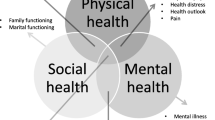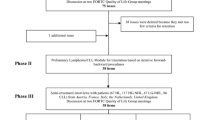Abstract
Background
Health-related quality of life (HRQOL) is a key aspect for chronic myeloid leukemia (CML) patients. The aim of this study was to develop a disease-specific HRQOL questionnaire for patients with CML to supplement the European Organization for Research and Treatment of Cancer (EORTC)-QLQ C30.
Patients and methods
The process followed a predefined and systematic stepwise iterative process as defined by the EORTC guidelines for questionnaire development. The process was divided into 3 phases: (1) generation of relevant HRQOL issues, (2) operationalization of the HRQOL issues into a set of items, and (3) pretesting the questionnaire for relevance and acceptability. Descriptive statistics and psychometric analyses were also performed.
Results
Overall, 655 CML patients were enrolled in 10 countries including the USA and countries in Europe and Asia. Interviews with health-care professionals experienced in CML (n = 59) were also conducted. Results from the interviews, clinical experiences, and statistical analyses were used to develop the EORTC QLQ-CML24. The final module consists of 24 items assessing the following aspects: symptom burden, impact on daily life and on worry/mood, body image problems, and satisfaction with care and with social life. Internal consistency, assessed with Cronbach’s alpha coefficients, ranged from 0.73 to 0.83 for the proposed scales.
Conclusion
The EORTC QLQ-CML24 is an internationally developed HRQOL questionnaire for CML patients, and its implementation in clinical research and practice can provide important information to facilitate clinical decision-making.


Similar content being viewed by others
References
Aaronson, N. K., Ahmedzai, S., Bergman, B., et al. (1993). The european organization for research and treatment of cancer QLQ-C30: a quality-of-life instrument for use in international clinical trials in oncology. Journal of the National Cancer Institute, 85, 365–376.
American Cancer Society: 2015 goals of the American Cancer Society. http://relay.acsevents.org/site/DocServer/ACS%20Mission%20Statement-2015%20Goals.pdf?docID_57443.
Basch, E., Abernethy, A. P., Mullins, C. D., et al. (2012). Recommendations for incorporating patient-reported outcomes into clinical comparative effectiveness research in adult oncology. Journal of Clinical Oncology, 30, 4249–4255.
Bjorkholm, M., Ohm, L., Eloranta, S., et al. (2011). Success story of targeted therapy in chronic myeloid leukemia: a population-based study of patients diagnosed in Sweden from 1973 to 2008. Journal of clinical oncology: Official journal of the American Society of Clinical Oncology, 29, 2514–2520.
Blazeby, J., Sprangers, MA., Cull, A. (2002) EORTC Quality of life group: guidelines for developing questionnaire modules. Report 3rd ed. Brussels: EORTC Quality of Life Group.
Cella, D., Jensen, S. E., Webster, K., et al. (2012). Measuring health-related quality of life in Leukemia: The Functional assessment of cancer Therapy–Leukemia (FACT-Leu) Questionnaire. Value Health, 15, 1051–1058.
Cortes, J., Hochhaus, A., Hughes, T., & Kantarjian, H. (2011). Front-line and salvage therapies with tyrosine kinase inhibitors and other treatments in chronic myeloid leukemia. Journal of Clinical Oncology, 29, 524–531.
Dewolf, L., Koller, M., Velikova, G., Johnson, C., Scott, N., Bottomley, A on behalf of the EORTC Quality of Life Group. EORTC Quality Of Life Group Translation Procedure. Report 3rd Ed. Brussels, 2009. http://groups.eortc.be/qol/sites/default/files/archives/translation_manual_2009.pdf.
Efficace, F., Baccarani, M., Breccia, M., et al. (2011). Health-related quality of life in chronic myeloid leukemia patients receiving long-term therapy with imatinib compared with the general population. Blood, 118, 4554–4560.
Efficace, F., Baccarani, M., Breccia, M., et al. (2013). Chronic fatigue is the most important factor limiting health-related quality of life of chronic myeloid leukemia patients treated with imatinib. Leukemia, 27, 1511–1519.
Efficace, F., Breccia, M., Saussele, S., et al. (2012). Which health-related quality of life aspects are important to patients with chronic myeloid leukemia receiving targeted therapies and to health care professionals? GIMEMA and EORTC Quality of Life Group. Annals of Hematology, 91, 1371–1381.
Efficace, F., Cardoni, A., Cottone, F., et al. (2013). Tyrosine-kinase inhibitors and patient-reported outcomes in chronic myeloid leukemia: A systematic review. Leukemia Research, 37, 206–213.
Efficace, F., Cocks, K., Breccia, M., et al. (2012). Time for a new era in the evaluation of targeted therapies for patients with chronic myeloid leukemia: inclusion of quality of life and other patient-reported outcomes. Critical Reviews in Oncology/Hematology, 81, 123–135.
Hahn, E. A., Glendenning, G. A., Sorensen, M. V., et al. (2003). Quality of life in patients with newly diagnosed chronic phase chronic myeloid leukemia on imatinib versus interferon alfa plus low-dose cytarabine: results from the IRIS Study. Journal of Clinical Oncology, 21, 2138–2146.
Hehlmann, R., Lauseker, M., Jung-Munkwitz, S., et al. (2011). Tolerability-adapted imatinib 800 mg/d versus 400 mg/d versus 400 mg/d plus interferon-alpha in newly diagnosed chronic myeloid leukemia. Journal of Clinical Oncology, 29, 1634–1642.
Hochhaus, A. (2011). Managing chronic myeloid leukemia as a chronic disease. American Society of hematology Educational Program Book. Hematology:128–135, doi:10.1182/asheducation-2011.1.128.
Johnson, C., Aaronson, N., Blazeby, J., Bottomley, A., Fayers, P., Koller, M., et al. (2011) Guidelines for developing Questionnaire modules. Report 4th Ed. Brussels.
Kantarjian, H. M., Hochhaus, A., Saglio, G., et al. (2011). Nilotinib versus imatinib for the treatment of patients with newly diagnosed chronic phase, Philadelphia chromosome-positive, chronic myeloid leukaemia: 24-month minimum follow-up of the phase 3 randomised ENESTnd trial. Lancet Oncol, 12, 841–851.
Kantarjian, H. M., Shah, N. P., Cortes, J. E., et al. (2012). Dasatinib or imatinib in newly diagnosed chronic-phase chronic myeloid leukemia: 2-year follow-up from a randomized phase 3 trial (DASISION). Blood, 119, 1123–1129.
Kantarjian, H., Shah, N. P., Hochhaus, A., et al. (2010). Dasatinib versus imatinib in newly diagnosed chronic-phase chronic myeloid leukemia. New England Journal of Medicine, 362, 2260–2270.
Marin, D. (2012) Initial choice of therapy among plenty for newly diagnosed chronic myeloid leukemia. American Society of Hematology Educational Program Book. Hematology. 2012:115–121, doi:10.1182/asheducation-2012.1.115.
Marin, D., Bazeos, A., Mahon, F. X., et al. (2010). Adherence is the critical factor for achieving molecular responses in patients with chronic myeloid leukemia who achieve complete cytogenetic responses on imatinib. Journal of Clinical Oncology, 28, 2381–2388.
National Cancer Institute. The NCI strategic plan for leading the nation. to eliminate the suffering and death due to cancer. National Institutes of Health Publication No. 06-5773. http://strategicplan.nci.nih.gov/pdf/nci_2007_strategic_plan.pdf.
Noens, L., van Lierde, M. A., De Bock, R., et al. (2009). Prevalence, determinants, and outcomes of nonadherence to imatinib therapy in patients with chronic myeloid leukemia: the ADAGIO study. Blood, 113, 5401–5411.
Nunnally, J. C. (1978). Psychometric theory (2nd ed.). New York: McGraw-Hill.
Phillips, K. M., Pinilla-Ibarz, J., Sotomayor, E., et al. (2013). Quality of life outcomes in patients with chronic myeloid leukemia treated with tyrosine kinase inhibitors: a controlled comparison. Supportive Care in Cancer, 21, 1097–1103.
Pinilla-Ibarz, J., Cortes, J., & Mauro, M. J. (2011). Intolerance to tyrosine kinase inhibitors in chronic myeloid leukemia: Definitions and clinical implications. Cancer, 117, 688–697.
Saglio, G., Kim, D. W., Issaragrisil, S., et al. (2010). Nilotinib versus imatinib for newly diagnosed chronic myeloid leukemia. New England Journal of Medicine, 362, 2251–2259.
US Food and Drug Administration: Guidance for Industry. Patient-reported outcome measures: use in medical product development to support labeling claims. u.s. department of health and human services food and drug administration December, 2009 http://www.fda.gov/downloads/Drugs/GuidanceComplianceRegulatoryInformation/Guidances/UCM193282.pdf.
Williams, L. A., Gonzalez, A. G., Ault, P., et al. (2013). Measuring the symptom burden associated with the treatment of chronic myeloid leukemia. Blood, 122, 641–647.
Acknowledgments
This study was supported by a research grant from the EORTC Quality of Life Group. Also, additional support for the conduct of the study was provided by the Italian Group for Adult Hematologic Diseases (GIMEMA). We are grateful to all the patients who participated in this study. We also thank Felice Bombaci and Giora Sharf (from the CML Advocates Network) for their invaluable help in representing the unique patients’ perspective throughout the development process. We also thank Dagmara Kulis from the EORTC Quality of Life Department (Brussels) for support in coordinating language translations. Finally, we also express our gratitude to Bernhard Holzner and Marianne Hjermstad for reviewing the module development report on behalf of the EORTC Quality of Life Group. Dr. Susanne Saussele is supported by DJCLS R 10/20.
Conflict of interest
Consultancy: F. E (Novartis Pharma, Bristol Myers Squibb), Honoraria: F. C (Novartis Pharma, Bristol Myers Squibb), and Speaking fees: F. G (Novartis Pharma, Bristol Myers Squibb, Ariad).
Author information
Authors and Affiliations
Corresponding author
Additional information
This study was conducted on behalf of EORTC Quality of Life Group.
Presented in part at the 53rd Annual Meeting of the American Society of Hematology (ASH). December 10–13, 2011, San Diego (CA), USA.
Rights and permissions
About this article
Cite this article
Efficace, F., Baccarani, M., Breccia, M. et al. International development of an EORTC questionnaire for assessing health-related quality of life in chronic myeloid leukemia patients: the EORTC QLQ-CML24. Qual Life Res 23, 825–836 (2014). https://doi.org/10.1007/s11136-013-0523-5
Accepted:
Published:
Issue Date:
DOI: https://doi.org/10.1007/s11136-013-0523-5




